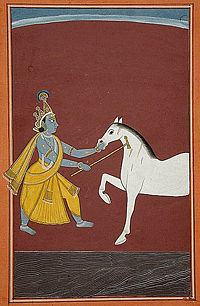Keshi is the horse-demon, killed by Krishna, an avatar of god Vishnu.
Etymology
Kesi, Nominative singular masculine from the root Kesin, literally long haired
Origin
Keshi, the "hairy one", first appears as a demon that attacks the unborn in the Atharvaveda. The passage reads:
Let us keep the black asura Kesin, born in the reed clump, snout-mouthed and all other harmful creatures, away from her genitals and her loins.
Meanwhile, Phyllis Granoff argues that the Keshi, who was killed by Krishna, is a demon of childhood diseases. The tales of Keshi-vadha ("The killing of Keshi") was well-known in the Kushan period (60-375 CE).
Story
Keshi's legend is recounted in the tenth Book of the Bhagavata Purana (between 500 CE - 1000 CE). Kamsa, the evil king of Mathura and the maternal uncle of Krishna, was destined to be killed by Krishna. In an attempt to avoid his death, Kamsa sent a series of demons to Gokula, where Krishna was staying with his foster-parents. After Krishna killed the bull demon Arishta - dispatched by Kamsa, the divine sage Narada confirmed to Kamsa that Krishna was his sister Devaki's child and that the girl-child that Kamsa had killed mistaking her as the child of Devaki, was in fact the daughter of Yashoda, Krishna's foster-mother. Infuriated n upohearing this, Kamsa called the demon Keshi and ordered him to kill Krishna and his brother Balarama.
Keshi assumed the form of a huge horse, who galloped at the speed of thoughts, wore the earth with his hooves and scattered celestial vehicles and clouds in the sky with his mane. His neighing terrified the people. So, Krishna challenged Keshi to a duel, as the horse was creating havoc around Gokula. Keshi roared like a lion and charged towards Krishna striking him with the hooves. Krishna caught hold of Keshi's two legs and tossed him to a great distance. Recovering from his fall, the agitated Keshi opened his mouth and attacked Krishna. As soon as Krishna thrust his left arm into Keshi's mouth, all of Keshi's teeth fell. Soon, Krishna's arm suddenly started expanding. Keshi choked to death, as sweat flowed from his body, his eyes rolled and he struggled kicking his feet. As Keshi fell lifeless on the ground assuming his true demon form, the gods and Narada extolled Krishna. Narada thanked Krishna for slaying the horse-demon with such ease, by whose neighing alone, the gods were abandoning heaven. He further prophesies the great deeds that Krishna will perform later, including the killing of Kamsa.
The fourth Book of the Vishnu Purana (between 1st century BCE to 4th century CE) also tells the story. However, Keshi first appears in the episode when Kamsa calls the host of his demons to kill all male children, once he realizes Krishna is born. Chapters 15 and 16 of the fourth Book present a detailed account of Keshi's death which parallels the Bhagavata Purana account. The narrative of Arishta's death, Narada's disclosure to Kamsa and the subsequent ordering of Keshi is the same. Though the terror by Keshi on earth and sky and Krishna's challenge is the same, the fight starts directly with Keshi attacking Krishna with his opened mouth. The hand of Krishna choked Keshi at the same time, tearing his body into two halves. The splitting of Keshi's body is not told in Bhagavata Purana. Narada's eulogy and prophesy about Kamsa's death follows the account, where Narada decreed that Krishna would be called Keshava, the slayer of Keshi. The same story was also narrated in the Harivamsa from the epic Mahabharata.
References
- Krishna: the Beautiful Legend of God: (Srimad Bhagavata Purana Book X), Book 10 by Edwin F. Bryant
- The Vishńu Puráńa: a system of Hindu mythology and tradition by Horace Hayman Wilson (1868). Fitzedward Hall. ed

